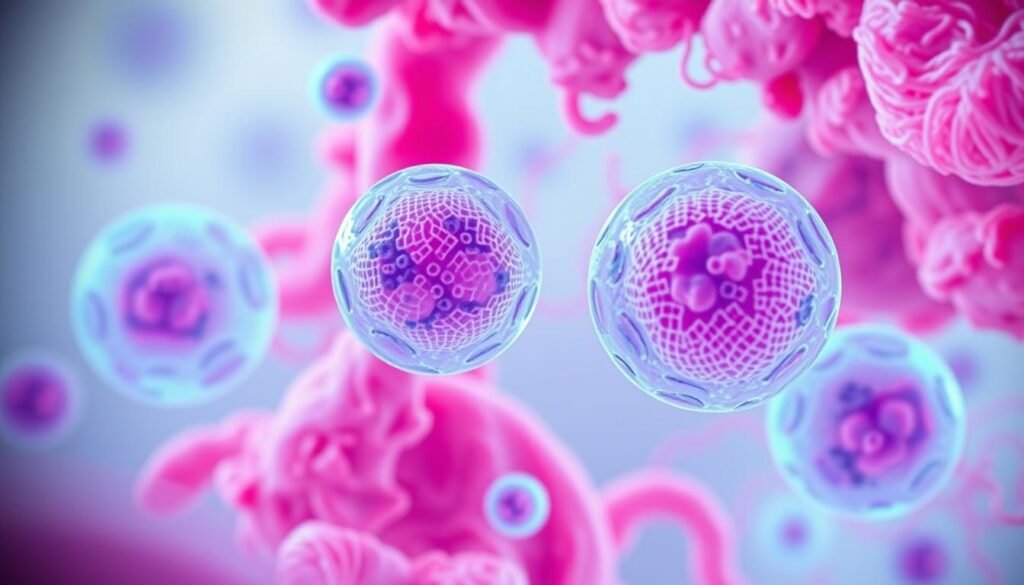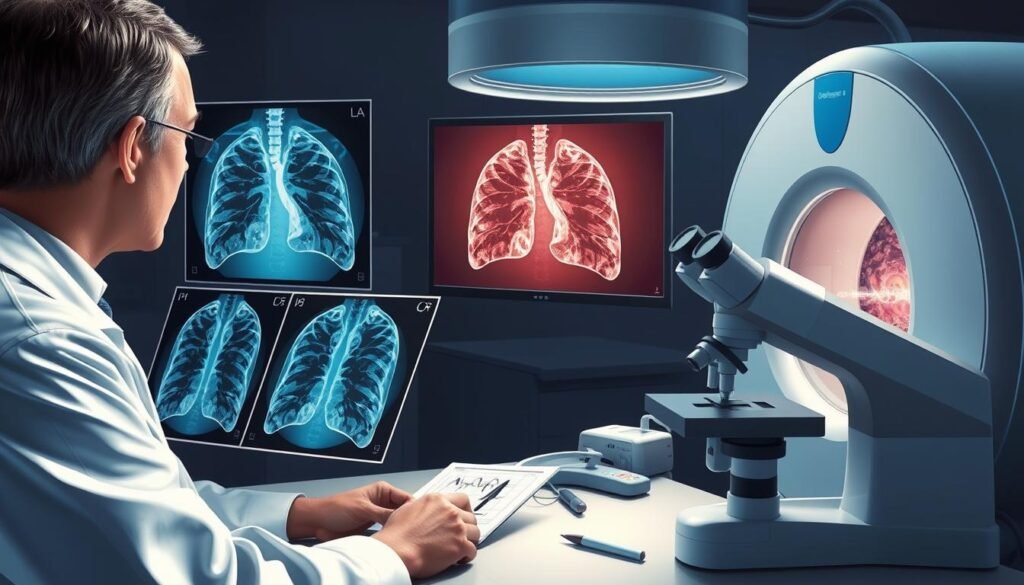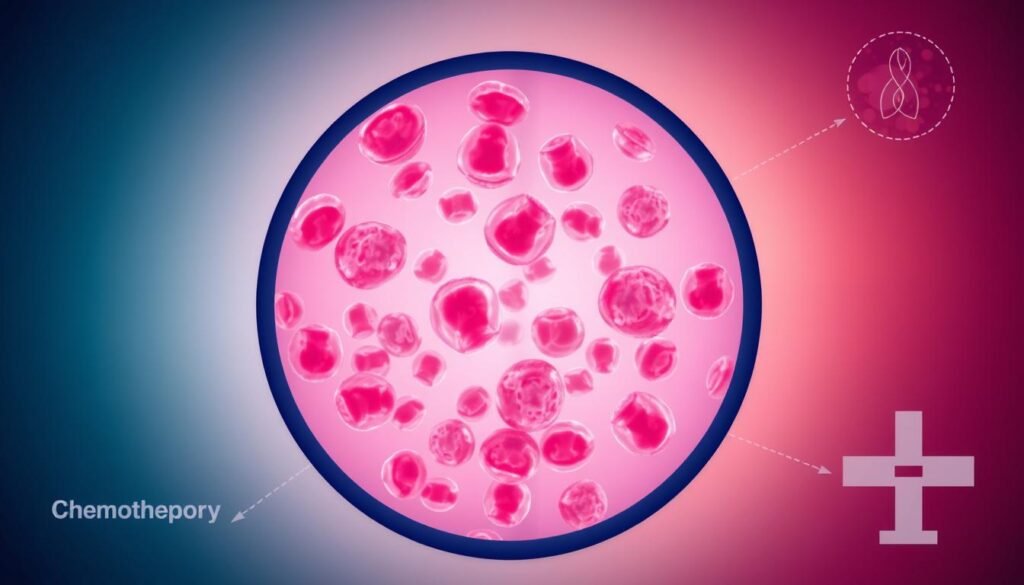Small cell lung cancer makes up 10-15% of all lung cancers. Yet, it has one of the highest death rates among them. Even though fewer people get this kind, those diagnosed often face tough odds, especially in late stages. Knowing about small cell lung cancer’s outlook is key for patients and families, as catching and treating it early can make a big difference in survival.
We aim to explore what affects small cell lung cancer outcomes. This includes signs, how it’s found, ways to treat it, and survival chances. With around 66% of people found to have widespread SCLC, knowing your options for treatment is critical. Armed with the right info, patients and those caring for them can find the best path forward and support.
Key Takeaways
- Small cell lung cancer represents 10-15% of lung cancers.
- About 33% of cases are diagnosed at the limited stage.
- The 5-year survival rate for early-stage SCLC is 27%.
- Most patients (66%) are diagnosed with extensive stage SCLC.
- Effective treatment options include chemotherapy and immunotherapy.
- Early diagnosis is critical for improving prognosis.
Overview of Small Cell Lung Cancer
Small cell lung cancer (SCLC) is about 15% of lung cancers. It’s known for being very aggressive, growing fast and spreading quickly. Knowing about SCLC means understanding its type and features. SCLC tumors usually start in the central parts of the lungs. Smoking is a big risk factor for this cancer.
SCLC is split into two types: small cell carcinoma and combined small cell carcinoma. Most cases are the small cell type. About 30% of people found with SCLC have it in limited areas. If the cancer spreads more, it’s called extensive-stage disease. Over the years, fewer people have been getting and dying from SCLC in the U.S.
In 2024, there were about 234,580 new cases of lung cancer in the U.S. This number includes SCLC and NSCLC. Sadly, around 125,070 deaths occurred. The 5-year survival rate for SCLC is very low, between 5% to 10%. Those with cancer in limited areas live longer, about 16 to 24 months. But, survival drops to 6 to 12 months when the disease spreads more.
Using radiation on the head early can prevent cancer from coming back in the brain. This helps some patients live longer. Adding radiation in the chest to chemotherapy also helps. It increases survival by about 5% over chemotherapy alone. More young women in the U.S. are getting SCLC now. This is different from before.
Studies have looked at SCLC changes over the last 30 years. This includes looking at records from the Surveillance, Epidemiologic, and End Results database. They’ve also studied how stopping smoking affects lung cancer at early stages. It’s important to understand SCLC to manage this tough disease well.
What is Small Cell Lung Cancer?
Small cell lung cancer (SCLC) is a very aggressive type of lung cancer. It mainly starts in the bronchi. Often, it’s not caught early because it doesn’t show clear symptoms until it’s quite advanced. Around 15% of all lung cancers are SCLC. This shows how common it is among lung cancers.
Smoking cigarettes is a big risk factor for developing SCLC. Nearly all cases are linked to tobacco use. It’s very rare in people who don’t smoke. This highlights the importance of quitting smoking to prevent it. Men get SCLC more often than women. This points to differences in risk factors between the sexes.
SCLC grows fast and spreads quickly to other body parts like the brain, liver, and bone. It’s usually too advanced for surgery by the time it’s found. So, treatments like chemotherapy and radiation therapy are used instead. These treatments can help with symptoms and extend life but usually don’t cure the disease.
It’s important to understand what SCLC is for patients and their doctors. Having the right information is key for the best treatment. For example, the ICD-10 code C34.2 is critical for correct diagnosis and care of people with SCLC.

Small Cell Lung Cancer Symptoms
Knowing the signs of small cell lung cancer early can save lives. This cancer can be sneaky, showing few signs until it’s advanced. Look out for these symptoms:
- Persistent cough that gets worse.
- Shortness of breath, especially when active.
- Chest pain, either sharp or dull.
- Fatigue that slows you down.
- Weight loss without trying.
When the cancer grows, symptoms like wheezing and facial swelling may appear. Smokers especially need to watch for these signs.
It’s important to know these symptoms are not just a cold. Acting quickly and talking to a doctor can make a big difference. They may do tests like chest x-rays or biopsies to figure out if it’s cancer. To learn more, check out this informative source.
| Symptom | Description | Importance |
|---|---|---|
| Persistent Cough | A cough that doesn’t go away or gets worse | Can show lungs are getting worse |
| Shortness of Breath | Hard to breathe during everyday tasks | Could mean blockage or fluid in lungs |
| Chest Pain | Pain or discomfort in the chest | Might be tumors pressing on something |
| Fatigue | Extreme tiredness that affects your day | May mean your body is fighting cancer |
| Weight Loss | Losing weight without trying | Could be how cancer affects your body |
Everyone should know these signs of small cell lung cancer, especially if you’ve smoked or been around harmful stuff. Finding it early helps with getting the right treatment.
Diagnosis of Small Cell Lung Cancer
The diagnosis of small cell lung cancer (SCLC) starts with careful checks. These include physical exams and looking over medical history. Often, doctors refer patients for tests if they show signs or have odd X-ray results. Finding the disease early is key to helping patients do better.
To diagnose SCLC, doctors use high-tech scans like multidetector CT scans, MRIs, and PET scans. These scans give detailed views of the disease in the lungs and nearby nodes. This helps doctors see how far the cancer has spread.
For a sure diagnosis, biopsy procedures are essential. There are many ways to get tissue samples, like fine and core needle biopsies, bronchoscopy, and EBUS. Each method has its advantages for getting the needed samples for testing.
SCLC is grouped into two stages: limited-stage and extensive-stage. In limited-stage, the cancer stays in one lung and nearby nodes. Extensive-stage means the cancer has spread more widely. Specialists like surgical, medical, and radiation oncologists decide on treatments together. They aim to choose the best plan for each patient.

| Staging Type | Description | Implications for Treatment |
|---|---|---|
| Limited Stage | Cancer found in one lung and nearby lymph nodes | Potential for surgery, chemotherapy, and radiotherapy |
| Extensive Stage | Cancer has spread beyond the lung | Primarily treatment with chemotherapy and palliative care |
In summary, finding out if someone has small cell lung cancer requires many steps. These steps are very important for deciding on the best treatment. This approach is crucial for improving how patients recover and their overall care.
Treatment Options for Small Cell Lung Cancer
Treatment for small cell lung cancer (SCLC) depends on how far the disease has spread and the patient’s health. A team of healthcare experts works together to plan the best approach. This team might include doctors, nurses, and other specialists.
For those with limited-stage SCLC, options can include:
- Chemotherapy combined with radiation therapy focused on the chest.
- Surgery for a single tumor, especially if found very early.
- Chemoradiotherapy, which uses both chemotherapy and radiation for better results.
For extensive-stage disease, the main treatment is chemotherapy, possibly with:
- Chemotherapy with or without immunotherapy drugs like atezolizumab or durvalumab.
- Prophylactic cranial irradiation to stop the cancer from reaching the brain.
- Medicine to manage symptoms for those choosing not to have aggressive treatment.
About 20-30% of patients have chemotherapy alone. Others might get chemoradiotherapy or brain radiation. Side effects like tiredness and hair loss can happen but usually get better after treatment. If treated with chemotherapy, people with limited-stage SCLC typically live about 18 months.
| Treatment Option | Target Stage | Typical Procedure | Median Survival Rate |
|---|---|---|---|
| Chemotherapy | Limited & Extensive | Administered in cycles (1-3 days every 3 weeks) | 18 months (Limited Stage) |
| Chemoradiotherapy | Limited | Concurrent chemotherapy and radiation | Variable, often improved outcomes |
| Surgery | Early Stage | Lobectomy or tumor removal | 18 months (Limited Stage) |
| Immunotherapy | Extensive | Combined with chemotherapy | Depends on response |
| Prophylactic Cranial Irradiation | Extensive | Targeted radiation to the brain | Not conclusively defined |
Knowing the treatment options helps patients and doctors decide the best path. They aim to extend life and enhance its quality, especially for advanced cases where a cure is hard to achieve.
Small Cell Lung Cancer Prognosis
Understanding small cell lung cancer (SCLC) prognosis involves many factors. These include the stage at diagnosis, health, and how well treatments work. This info helps picture future expectations. It allows patients and their families to help plan treatment.
Factors Affecting Prognosis
Several factors impact the small cell lung cancer prognosis:
- The cancer’s stage at diagnosis is critical, with early stage SCLC having better outcomes than later stages.
- Patients in good overall health often experience better prognosis and treatment outcomes.
- Weight loss before treatment and existing lung or heart issues can lower survival chances.
- Genetic changes in cancer cells can make some treatments more or less effective.
- A patient’s ability to do daily tasks is linked to higher survival rates.
- Quitting smoking at diagnosis greatly improves survival chances.
Understanding Survival Rates
Survival rates for small cell lung cancer vary widely. They depend on the cancer’s stage and the patient’s overall health:
| Stage | 5-Year Relative Survival Rate |
|---|---|
| Limited Stage | 30% |
| Regional Stage | 18% |
| Distant Stage | 3% |
| All Stages Combined | 7% |
The median survival for limited stage SCLC is 15 to 20 months. For extensive stages, it drops dramatically, showing the disease’s aggressive nature. Quitting smoking and getting treatments like radiotherapy and chemotherapy help with the prognosis.
Small Cell Lung Cancer Stage 4 Prognosis
Stage 4 small cell lung cancer is the most advanced stage. Here, the focus is often on easing symptoms, not cure. Median survival for this stage is usually 7 to 11 months. Even though it’s tough, current treatments can improve life quality.

Small Cell Lung Cancer Survival Rates
Survival rates for small cell lung cancer can tell us a lot about what patients can expect. The outcome greatly depends on when the cancer is found and how well treatments work. Knowing that finding it early can make a big difference is key.
In Stage 1, about 65 out of 100 people (or 65%) live for five years or more. But, as cancer grows, survival chances decrease. In Stage 2, the rate drops to 40 out of 100 (or 40%). Stage 3 sees an even bigger fall, with 15 out of 100 (or 15%) living five years. By Stage 4, only 5 out of 100 (or 5%) survive that long.
Looking at SCLC data from different areas adds more insight. In England, about 45% of patients make it past one year. Roughly 20% live for at least five years. Only 10% survive for ten years.
The survival rate for early stages is higher, with a five-year survival rate of 27% for limited stage cancer. Regional disease has a 16% five-year survival rate. Advanced cancer with distant spread has a slim 3% chance of five-year survival.
Knowing these rates helps us understand cancer better. It highlights the importance of finding it early and getting the right treatment. Smoking is the main cause of this cancer. This underlines the need for awareness, prevention, and screening, especially for high-risk groups.
For more data about lung cancer, check out key statistics on lung cancer.
Life Expectancy in Small Cell Lung Cancer Patients
The small cell lung cancer life expectancy depends on many things. These include how early the cancer was found and how well the treatment works. On average, people with this cancer live about 16 months. Those with limited-stage cancer may live around 24 months. Yet, for extensive-stage cancer, the median survival time falls to 11 months.
Many factors affect a patient’s survival chances. Prognosis and survival improve with a good performance status, like ECOG 0-1 ratings. Good responses to treatments and preventive brain radiation also help. However, widespread cancer, especially in the liver, bones, or brain, lowers survival chances.
It’s important to see the big picture. Below is a table with key stats on small cell lung cancer life expectancy:
| Stage | Median Survival (Months) | 5-Year Survival Rate (%) |
|---|---|---|
| Limited Stage (LS-SCLC) | 12-16 | Approximately 20% |
| Extensive Stage (ES-SCLC) | 7-11 | Approximately 5% |
| Overall Small Cell Lung Cancer | 16 | N/A |
| Untreated Small Cell Lung Cancer | 2-4 | N/A |
Getting treatment quickly is key to living longer for people with small cell lung cancer. Changes in lifestyle, plus medical treatments, help improve survival rates. Early cancer detection and active treatment can deeply change outcomes.
Recurrence Rates of Small Cell Lung Cancer
Small cell lung cancer (SCLC) has high recurrence rates. It makes up about 15% of all lung cancer cases. Sadly, more than 90% of SCLC patients see their cancer return within two years of treatment.
The outlook for SCLC when it comes back is not hopeful. Survival rates differ based on the disease’s stage at recurrence. Local recurrences see a 30% survival rate, regional at 18%, and distant at only 3%. This shows how tough it is to fight SCLC once it comes back.
Age matters when looking at survival times for recurrent SCLC. People between 18 to 49 can survive for 12 months on average. Those 50 to 69 have around 10.8 months. And individuals 70 or older have about 8.5 months. Across all ages, the average survival time is roughly 10.1 months.
Often, recurrent SCLC can’t be cured, which means treatments aim to ease symptoms. The cancer often spreads to the brain, liver, bones, and adrenal glands. It also tends to resist first treatments like platinum-based chemo, making it harder to manage.
After SCLC treatment, changing your lifestyle can help your health. Quitting smoking, staying active, and eating well can make a difference. It’s critical to keep up with doctor’s visits, especially for those with a SCLC history.
For more detailed information about prognosis and treatment options, please refer to this relevant study.
The Impact of Metastasis on Prognosis
The spread of lung cancer has a big impact on the outlook for small cell lung cancer (SCLC) patients. It’s key to know how and where SCLC spreads. This helps doctors choose the best treatment and predict survival chances. Around 60.6% of 251 SCLC patients had cancer that had spread far. The liver, bones, and brain were the most common places it spread to.
Where the cancer spreads affects survival rates. Studies show patients with cancer in one place survive longer than those with cancer in many places. Notably, liver and brain metastases are important factors. Only 14.5% of patients with liver metastases lived more than a year. Patients with brain metastases did a bit better, with a 21.6% survival rate. Those without any spread had a much better chance, highlighting the serious effect of the disease spreading.
Talking about small cell lung cancer metastasis prognosis is key for planning treatment. Data show that fluid in the chest or heart area and metastasis to specific organs meant a worse health status. Combining radiotherapy and chemotherapy can have mixed results. Knowing early if the cancer has spread can lead to better, more personalized treatment plans.
The overall chance of surviving SCLC is low, especially if it has spread, with a 5-year survival rate of only 3%. This emphasizes the urgent need for more research. Better treatments and ways to manage the disease could improve patient outcomes significantly.
| Metastatic Site | Percentage of Patients (%) | 1-Year Survival Rate (%) |
|---|---|---|
| Liver | 20.3 | 14.5 |
| Bone | 18.3 | Varies |
| Brain | 15.5 | 21.6 |
| Lung | 10.0 | Known to be more favorable |
| Adrenal Gland | 6.0 | Less significant |
Conclusion
Small cell lung cancer (SCLC) is tough to fight because of its aggressive behavior and high death rates. It makes up 15% of lung cancer cases, leading to around 250,000 new cases and 200,000 deaths each year worldwide. Most patients find out they have it when it’s already advanced.
For those caught early, life can extend to 15-20 months. But with widespread disease, survival falls to 6-12 months. It’s clear that finding the disease early and choosing the right treatment is key to living longer.
Research is crucial in learning more about SCLC and finding better treatments. Even though SCLC is becoming less common in the USA, it’s still a big problem. There’s a strong need for more studies to understand how to beat this cancer.
Even though the numbers look bad, there’s still hope for new treatments. Putting effort into research is important for overcoming SCLC. We aim to find better ways to help those facing this challenging type of lung cancer.